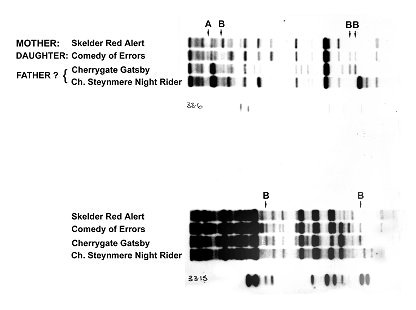Added note, February 2006:
This report was included both because of its relevance for UK Boxer pedigrees (see article on brindle, below) and because of its historical interest in being perhaps the first dog paternity study conducted in the UK and accepted by the Kennel club.
I expect that most people are aware of the mishap that led to the Claire Kay’s new champion Boxer, Ch Comedy of Errors from Skelder, being registered as having two sires. The dam, Skelder Red Alert, owned by Michael Gray on breedig terms from Joy Malcolm, was brought for mating to our aging Ch Steynmere Night Rider. The following day she was accidentally mated by Michael’s own dog, Cherrygate Gatsby, which previously had refused to pay any interest in her – the classic story. Some 9 weeks later a litter appeared; the problem was whose?
When the pups were 6 – 7 weeks old, Michael, Joy, Margaret and I met together to look at the litter and decide what to do. The clear pick of litter, who became Ch Comedy of Errors was, as far as I was concerned was the only one who could have been by Night Rider; but she really did not look like what one would expect from Night Rider and the very elegant Red Alert. She still doesn’t, but she so closely resembled Night Rider’s mum, Ch Kalendar’s Gold Mink of Steynmere, in both head and body type that it seemed quite possible that Night Rider could indeed be her sire. The trouble was that as Red Alert was herself a Night Rider grand-daughter there was more than one explanation for the similarity.
The new technique of DNA finger printing seemed the only way of resolving Comedy of Error’s paternity. Accordingly, the standard 5cc of blood was collected from each of the putative fathers, from the dam and from each of the 5 pups and sent in a preservative to Professor Morton, at Leicester University (now Birmingham). Professor Morton is responsible for organising the material for subsequent analysis by the commercial company Cellmark who have patented the particular technique necessary for the analysis. Regrettably, all the effort came to nought because the Cellmark work was just getting started at that time and their demand for their services for human problems was overwhelming. It would have taken 6 – 9 months to get a result. Consequently, the exercise was abandoned and, in accord with the practice laid down by the Kennel Club, the litter was registered with 2 sires. There the matter would have ended but for the fact that Joy took on Comedy of Errors, showed her for a while with notable success and then sold her to Claire Kay who has since campaigned her to the top. It was the Claire decided that she must find out which of the two dogs really was the sire; and the whole procedure started again although this time with all the pups other than Comedy of Errors excluded. Cellmark was now in full operation and the results came back within 2 – 3 weeks. The evidence they provided is shown in the accompanying figure.
A brief description of the DNA fingerprinting technique is perhaps warranted to help interpretation.
The basic genetic material, DNA, is first extracted from the blood cells. This is then broken up into fragments by certain enzymes which cut the DNA at certain specific sites. These fragments have an electrical charge. Therefore, by subjecting them to an electrical current in a gel (electrophoresis) the fragments are induced to move towards the positive pole. The amount of movement depends upon the size of the fragments and their electrical charge. Hence, the electrophoresis separates them into a series of bands. These can then be visualised with the use of radio-labelled probes which bind to specific repeat copies of 4 chemical bases in the DNA fragments.
The latter are the key factor for the DNA imprinting. The repeat copies may be present in small or quite large numbers and this variation contributes to the variation in DNA fragment size. The function of this special DNA is not clearly understood. While generally inherited in a constant manner, it is much more variable than that for single Mendelian genes and this accounts for the large degree of variation between individual dogs. The changes represent alterations in the numbers of repeat copies. The frequency of such changes in dogs is not known but in humans the estimate is 0.4% (4 changes in every thousand germ cells). These units cannot be regarded as Mendelian genes but apart from their variability are subject to Mendelian inheritance such that all the bands that a pup possesses must be inherited from one, or other, or both of it's parents.
The exercise for Comedy of Errors is therefore to seek the paternal origin (Night Rider or Gatsby) of all bands that she had not inherited from her mother. Two sets of results are shown in the figure, one with probe 33.6 and another with probe 33.15. According to Cellmark, Comedy of Errors has a total of 5 bands visualised with the two probes that could only have come from Gatsby. This establishes him as the father. She has one band, however, that could not have come from either parent. This can be regarded as a new mutation.
I have marked what I believe must be the 'mutated' band with an A, and each of the 5 that identify Gatsby as Comedy of Errors' father with a B. Do you agree? [Note: the figure was prepared before Comedy of Errors became a champion.]


